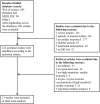Kinetics, Moderators and Reference Limits of Exercise-Induced Elevation of Cardiac Troponin T in Athletes: A Systematic Review and Meta-Analysis
- PMID: 33841187
- PMCID: PMC8033011
- DOI: 10.3389/fphys.2021.651851
Kinetics, Moderators and Reference Limits of Exercise-Induced Elevation of Cardiac Troponin T in Athletes: A Systematic Review and Meta-Analysis
Abstract
Background: Kinetics, moderators and reference limits for exercise-induced cardiac troponin T (cTnT) elevations are still unclear. Methods: A systematic review of published literature was conducted adhering to the Preferred Reporting Items for Systematic Review and Meta-Analyses (PRISMA) guidelines. Studies reporting high-sensitivity cardiac troponin T (hs-cTnT) concentrations before and after a bout of exercise in athletes were included and analyzed. The final dataset consisted of 62 estimates from 16 bouts in 13 studies of 5-1,002 athletes (1,421 in total). Meta-analysis was performed using general linear mixed modeling and Bayesian inferences about effect magnitudes. Modifying fixed-effect moderators of gender, age, baseline level, exercise duration, intensity and modalities were investigated. Simulation was used to derive 99th percentile with 95% limits of upper reference ranges for hs-cTnT of athletic populations. Results: The mean and upper reference limits of hs-cTnT before exercise were 4.4 and 19 ng.L-1. Clear increases in hs-cTnT ranging from large to very large (factor changes of 2.1-7.5, 90% compatibility limits, ×/÷1.3) were evident from 0.7 through 25 h, peaking at 2.9 h after the midpoint of a 2.5-h bout of running, when the mean and upper reference limit for hs-cTnT were 33 and 390 ng L-1. A four-fold increase in exercise duration produced a large clear increase (2.4, ×/÷1.7) in post-exercise hs-cTnT. Rowing exercise demonstrated an extremely large clear reduction (0.1 ×/÷2.4). Conclusions: The kinetics of cTnT elevation following exercise, the positive effect of exercise duration, the impact of exercise modality and 99th upper reference limits for athletic populations were reasonably well defined by this meta-analysis.
Keywords: cardiac biomarker; cycling; marathon; reference range; running; swimming; time-course; triathlon.
Copyright © 2021 Li, Hopkins, Wang, Baker, Nie, Qiu, Quach, Wang and Yi.
Conflict of interest statement
The authors declare that the research was conducted in the absence of any commercial or financial relationships that could be construed as a potential conflict of interest.
Figures



Similar articles
-
Exercise training and high-sensitivity cardiac troponin T in patients with heart failure with reduced ejection fraction.ESC Heart Fail. 2021 Jun;8(3):2183-2192. doi: 10.1002/ehf2.13310. Epub 2021 Mar 23. ESC Heart Fail. 2021. PMID: 33754453 Free PMC article. Clinical Trial.
-
Direct comparison of clinical decision limits for cardiac troponin T and I.Heart. 2016 Apr;102(8):610-6. doi: 10.1136/heartjnl-2015-308917. Epub 2016 Jan 21. Heart. 2016. PMID: 26794233
-
Reference population and marathon runner sera assessed by highly sensitive cardiac troponin T and commercial cardiac troponin T and I assays.Clin Chem. 2009 Jan;55(1):101-8. doi: 10.1373/clinchem.2008.106427. Epub 2008 Nov 6. Clin Chem. 2009. PMID: 18988757
-
High-Sensitivity Cardiac Troponin I and T Kinetics Differ following Coronary Bypass Surgery: A Systematic Review and Meta-Analysis.Clin Chem. 2022 Dec 6;68(12):1564-1575. doi: 10.1093/clinchem/hvac152. Clin Chem. 2022. PMID: 36366960
-
High-Sensitivity Cardiac Troponin After Cardiac Stress Test: A Systematic Review and Meta-Analysis.J Am Heart Assoc. 2019 Mar 19;8(6):e008626. doi: 10.1161/JAHA.118.008626. J Am Heart Assoc. 2019. PMID: 30871395 Free PMC article.
Cited by
-
Clinical and Diagnostic Value of Highly Sensitive Cardiac Troponins in Arterial Hypertension.Vasc Health Risk Manag. 2021 Jul 31;17:431-443. doi: 10.2147/VHRM.S315376. eCollection 2021. Vasc Health Risk Manag. 2021. PMID: 34366667 Free PMC article. Review.
-
The 4Rs Framework of Sports Nutrition: An Update with Recommendations to Evaluate Allostatic Load in Athletes.Life (Basel). 2025 May 27;15(6):867. doi: 10.3390/life15060867. Life (Basel). 2025. PMID: 40566521 Free PMC article. Review.
-
Cardiac involvement in female elite athletes with carrier status of Duchenne muscular dystrophy.Front Cardiovasc Med. 2025 Jul 7;12:1606994. doi: 10.3389/fcvm.2025.1606994. eCollection 2025. Front Cardiovasc Med. 2025. PMID: 40693222 Free PMC article. Review.
-
Cardiovascular risk of veterans' football: An observational cohort study with follow-up.PLoS One. 2024 Apr 5;19(4):e0297951. doi: 10.1371/journal.pone.0297951. eCollection 2024. PLoS One. 2024. PMID: 38578731 Free PMC article.
-
Effects of high-intensity interval exercise on cardiac troponin elevation when comparing with moderate-intensity continuous exercise: a systematic review and meta-analysis.PeerJ. 2023 Jan 11;11:e14508. doi: 10.7717/peerj.14508. eCollection 2023. PeerJ. 2023. PMID: 36647447 Free PMC article.
References
-
- Aakre K. M., Kleiven O., Skadberg O., Bjorkavoll-Bergseth M. F., Melberg T., Strand H., et al. . (2018). The copeptin response after physical activity is not associated with cardiac biomarkers or asymptomatic coronary artery disease: The North Sea Race Endurance Exercise Study (NEEDED) 2013. Clin. Biochem. 52, 8–12. 10.1016/j.clinbiochem.2017.10.007 - DOI - PubMed
Publication types
LinkOut - more resources
Full Text Sources
Other Literature Sources
Research Materials

